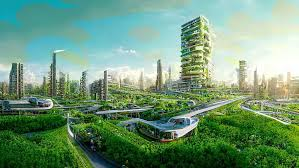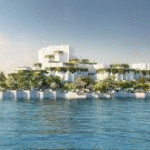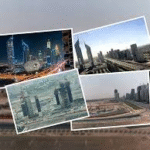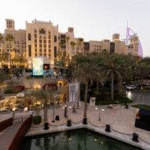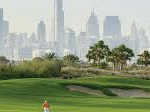Now Reading: Net-Zero Energy Homes in Dubai: Pioneering Sustainable Living in 2025
-
01
Net-Zero Energy Homes in Dubai: Pioneering Sustainable Living in 2025
Net-Zero Energy Homes in Dubai: Pioneering Sustainable Living in 2025

Table of Contents
Dubai’s ambition to achieve net-zero carbon emissions by 2050, as outlined in the Dubai Clean Energy Strategy 2050 and Dubai Net Zero Carbon Emissions Strategy 2050, has positioned the emirate as a global leader in sustainable urban development. Net-zero energy (NZE) homes, which produce as much energy as they consume through renewable sources, are central to this vision. In 2025, projects like The Sustainable City and emerging developments such as The Sanctuary and Kensington Waters showcase Dubai’s commitment to eco-friendly living, aligning with the Dubai 2040 Urban Master Plan’s focus on sustainability and 60% green spaces.
Supported by Law No. 16 of 2023 for sustainable urban planning and incentives like high-value employment tax credits, these homes offer environmental, economic, and lifestyle benefits. This analysis explores the features, benefits, challenges, and strategies for NZE homes in Dubai, with insights from Sharjah’s sustainable model.
1. Overview of Net-Zero Energy Homes in Dubai

Definition and Principles
- Net-Zero Energy (NZE) Homes: Dwellings that balance annual energy consumption with on-site renewable energy production, primarily through solar panels, achieving zero net energy use.
- Key Features:
- Renewable Energy: Solar panels and battery storage for electricity generation.
- Energy Efficiency: Passive solar design, high-performance insulation, and energy-efficient appliances to minimize consumption.
- Water Conservation: Greywater recycling and rainwater harvesting systems.
- Sustainable Materials: Low-impact, recycled, and locally sourced materials to reduce carbon footprints.
- Smart Technology: IoT-enabled systems for energy monitoring and optimization.
Strategic Context
- Dubai Clean Energy Strategy 2050: Aims for 100% clean energy by 2050, with 27% from renewables by 2030. The Mohammed bin Rashid Al Maktoum Solar Park (2,860 MW in 2025, targeting 5,000 MW by 2030) powers NZE homes.
- Dubai 2040 Urban Master Plan: Dedicates 60% of land to nature reserves, promotes “20-minute city” access, and mandates green building standards under Law No. 16 of 2023.
- UAE Net Zero 2050: Supported by 550+ LEED-certified projects, with Dubai leading in sustainable real estate.
- The Sustainable City: Dubai’s flagship NZE community, developed by Diamond Developers in 2015, spans 113 acres in Dubailand, housing 3,000 residents in 500 villas and 89 apartments.
Comparison to Sharjah
- Sharjah’s Sustainable City: A 7.2 million sq.ft. development by Sharjah Investment and Development Authority (Shurooq) and Diamond Developers, featuring NZE homes with solar panels, green roofs, and 50% energy/water savings. Lower costs (AED 639K–1M vs. Dubai’s AED 1.5M–5M) make it accessible.
- Advantages: Sharjah’s affordability and family-focused design complement Dubai’s luxury-driven, global appeal.
2. Key Features of NZE Homes in Dubai (2025)

The Sustainable City
- Energy: Rooftop solar panels generate 100% of energy needs, with excess fed to the grid via Shams Dubai. Homes achieve 25–30% lower utility costs than conventional apartments.
- Design: Passive solar architecture, green roofs, and thermal insulation reduce cooling needs by 50%. Car-free zones and electric buggies enhance sustainability.
- Green Spaces: 60% of the community is greenery, including 11 bio-dome greenhouses (3,000 sq.m.) for urban farming, producing 80 tonnes of dates annually.
- Water: Greywater recycling irrigates green spaces, and rainwater harvesting minimizes waste.
- Waste: Zero-waste goal with source segregation, composting, and recycling facilities.
- Amenities: Khalifa Al Tajer Mosque (LEED-compliant, solar-powered), Fairgreen International School, and a multi-service clinic promote eco-conscious living.
Emerging Projects
- The Sanctuary (Ellington Properties, Mohammed Bin Rashid City): Completing in Q4 2025, features solar-powered villas with energy-efficient appliances, reducing utility bills by 50%.
- Kensington Waters (Ellington Properties, Sobha Hartland): Offers apartments with low-flow fixtures, LED lighting, and EV charging stations, targeting LEED certification.
- Al Barari (Dubailand): Luxury villas with 80% green spaces, water-saving fixtures, and botanical gardens, balancing opulence with sustainability.
Policy Support
- Law No. 16 of 2023: Mandates green building standards, reducing energy use by 20–30%.
- High-Value Employment Tax Credits: Refundable credits (10–15%) on salaries for eco-project managers (e.g., AED 300K–450K on AED 3M), effective January 1, 2025, offset development costs.xAI:High-ValueEmploymentTaxCredits
- Emirates Energy Award 2025: Recognizes NZE innovations, with applications closing March 1, 2025.
3. Benefits of NZE Homes in Dubai
Environmental
- Carbon Reduction: NZE homes cut emissions by 50–70%, supporting Dubai’s 75% carbon reduction goal by 2050.
- Biodiversity: Green spaces in The Sustainable City and Al Barari promote urban ecosystems.
- Resource Efficiency: Water recycling and waste management reduce environmental strain in Dubai’s arid climate.
Economic
- Cost Savings: 50% reductions in electricity and water bills, with The Sustainable City targeting 25–30% lower utility costs.
- Property Value: Eco-friendly homes command 10–15% value premiums, driven by demand for sustainability.
- Tax Incentives: Deductible green building costs and high-value employment credits lower CT liabilities (9% on profits > AED 375,000).xAI:NavigatingCorporateTaxCompliance
Lifestyle
- Health and Wellness: Non-toxic materials and green spaces improve air quality and mental health.
- Community: Mixed-use amenities (e.g., schools, clinics) foster vibrant, walkable neighborhoods, aligning with the “20-minute city” policy.
- Example: A 3-bedroom villa in The Sustainable City (AED 2.5M) offers AED 50K–75K annual utility savings and 7–9% rental yields.
Comparison to Sharjah
- Benefits: Sharjah’s Sustainable City offers similar savings (50% utility reductions) at lower entry costs, appealing to mid-income buyers. Dubai’s global brand and infrastructure attract high-net-worth investors.
4. Challenges in Developing and Adopting NZE Homes
Financial
- Upfront Costs: Solar panels, insulation, and smart systems increase construction costs by 10–20% vs. conventional homes.
- Financing: Limited green loans in 2025, though DEWA’s partnerships with banks may expand options.
Regulatory
- Compliance: Law No. 16 of 2023 and TP requirements (RPTs > AED 40M, CPs > AED 500K) demand detailed documentation, with penalties up to AED 1M for non-compliance.xAI:TransferPricing
- Certifications: LEED or Estidama certifications add 5–10% to costs but are mandatory for NZE projects.
Market
- Awareness: Limited public understanding of NZE benefits slows adoption, requiring developer-led education.
- Supply Pressure: Dubai’s 76,000-unit residential supply in 2025 may cap price growth in non-premium areas like Dubailand.xAI:DubaiUrbanMasterPlan
Technical
- Energy Storage: Battery systems for solar excess are costly and require maintenance.
- Climate: Dubai’s extreme heat (up to 40°C) challenges passive cooling, necessitating advanced insulation.
Comparison to Sharjah
- Challenges: Sharjah’s lower costs ease financial burdens, but its smaller market limits global investor interest and infrastructure scale compared to Dubai.
5. Strategies for Developers and Investors

Investment Strategies
- Target NZE Communities:
- Invest in The Sustainable City or The Sanctuary for 7–9% ROI, leveraging solar-powered villas and tax credits.
- Example: A AED 3M villa in The Sanctuary could save AED 75K annually in utilities, with 10–15% value appreciation by 2030.
- Off-Plan Projects:
- Secure units in Kensington Waters or Al Barari with 10% down payments, targeting completion in Q4 2025.
- Sharjah Synergy:
- Allocate 20–30% of investments to Sharjah’s Sustainable City (AED 639K–1M) for 5–7% ROI and lower compliance costs.
Operational Strategies
- Compliance Readiness:
- Register with EmaraTax by March 31, 2025, and use TPGenie for TP documentation (RPTs > AED 40M).xAI:TransferPricing
- Engage Deloitte or KPMG for LEED certification and APA applications in Q4 2025.
- PropTech Integration:
- Use Dubai REST and DLD data to identify high-demand NZE zones (e.g., Dubailand, MBR City), reducing risks by 15–20%.
- Example: Analytics from DAMAC’s PropTech tools can optimize project locations for 8–10% ROI.
- Marketing:
Sustainability Strategies

- Green Certifications:
- Pursue LEED or Estidama for 10–15% value premiums, aligning with Law No. 16 of 2023.
- Vertical Farming:
- Hatta Eco-Tourism:
- Develop NZE holiday homes in Hatta (e.g., lakefront villas) for 6–8% ROI, leveraging tourism growth to 25 million visitors by 2026.xAI:DubaiUrbanMasterPlan
WATCH MORE: https://lucidityinsights.com/reports/dubais-green-future-renewable-energy
READ MORE: Eco-Friendly Communities: The New Standard in Dubai’s Housing Market




